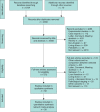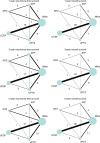Prognostic role of selection criteria for liver transplantation in patients with hepatocellular carcinoma: a network meta-analysis
- PMID: 35211739
- PMCID: PMC8874238
- DOI: 10.1093/bjsopen/zrab130
Prognostic role of selection criteria for liver transplantation in patients with hepatocellular carcinoma: a network meta-analysis
Abstract
Background: Patients with hepatocellular carcinoma (HCC) are selected for transplantation if they have a low tumour burden and low risk of recurrence. The morphometric Milan criteria have been the cornerstone for patient selection, but dynamic morphological and biological tumour characteristics surfaced as an encouraging tool to refine the selection of patients with HCC and to support the expansion of the Milan criteria. The outcomes of the most prevalent models that select patients with HCC for liver transplantation were analysed in this study, which aimed to identify the selection model that offered the best recurrence-free and overall survival after transplantation.
Methods: Studies that compared Milan, University of California San Francisco (UCSF), up-to-seven (UPTS), alpha-fetoprotein (AFP), and MetroTicket 2.0 (MT2) models were included. One-year, 3-year, and 5-year recurrence-free and overall survival rates of patients selected for transplantation using different models were analysed.
Results: A total of 60 850 adult patients with HCC selected for liver transplantation using Milan, UCSF, UPTS, AFP, or MT2 criteria were included. Patients selected for transplantation using the MT2 model had the highest 1-, 3-, and 5-year recurrence-free survival. In addition, patients selected for transplantation using MT2 criteria had the best 1- and 3-year overall survival, whereas patients selected for transplantation using the Milan criteria had the best 5-year overall survival rates.
Conclusion: The MT2 model offered the best post-transplant outcomes in patients with HCC, highlighting the importance of considering tumour morphology and biology when selecting patients with HCC for liver transplantation.
© The Author(s) 2022. Published by Oxford University Press on behalf of BJS Society Ltd.
Figures



Comment in
-
Selection criteria in liver transplantation for hepatocellular carcinoma: an ongoing evolution.BJS Open. 2022 Jan 6;6(1):zrac024. doi: 10.1093/bjsopen/zrac024. BJS Open. 2022. PMID: 35199141 Free PMC article. No abstract available.
Similar articles
-
Homocysteine: A novel prognostic biomarker in liver transplantation for alpha-fetoprotein- negative hepatocellular carcinoma.Cancer Biomark. 2020;29(2):197-206. doi: 10.3233/CBM-201545. Cancer Biomark. 2020. PMID: 32623388
-
Shadows Behind Using Simple Risk Models in Selection of Hepatocellular Carcinoma Patients for Liver Transplantation.Ann Surg. 2020 Jun;271(6):1124-1131. doi: 10.1097/SLA.0000000000003176. Ann Surg. 2020. PMID: 30601254
-
Combination of morphologic criteria and α-fetoprotein in selection of patients with hepatocellular carcinoma for liver transplantation minimizes the problem of posttransplant tumor recurrence.World J Surg. 2014 Oct;38(10):2698-707. doi: 10.1007/s00268-014-2647-3. World J Surg. 2014. PMID: 24858191 Free PMC article.
-
Do We Need to Be Limited by Matching Milan Criteria for Survival in Living Donor Liver Transplantation?J Gastrointest Cancer. 2020 Dec;51(4):1107-1113. doi: 10.1007/s12029-020-00482-0. J Gastrointest Cancer. 2020. PMID: 32857265 Review.
-
Patient Selection for Downstaging of Hepatocellular Carcinoma Prior to Liver Transplantation-Adjusting the Odds?Transpl Int. 2022 Apr 21;35:10333. doi: 10.3389/ti.2022.10333. eCollection 2022. Transpl Int. 2022. PMID: 35529597 Free PMC article. Review.
Cited by
-
Prognostic role of selection criteria for liver transplantation in patients with hepatocellular carcinoma: Review and bibliometric.ILIVER. 2024 Feb 6;3(1):100077. doi: 10.1016/j.iliver.2024.100077. eCollection 2024 Mar. ILIVER. 2024. PMID: 40636728 Free PMC article. Review.
-
Therapeutic Approach to Post-Transplant Recurrence of Hepatocellular Carcinoma: Certainties and Open Issues.Cancers (Basel). 2023 Nov 26;15(23):5593. doi: 10.3390/cancers15235593. Cancers (Basel). 2023. PMID: 38067299 Free PMC article. Review.
-
Validation of the Toronto recurrence inference using machine-learning for post-transplant hepatocellular carcinoma model.Commun Med (Lond). 2025 Jul 9;5(1):284. doi: 10.1038/s43856-025-00994-5. Commun Med (Lond). 2025. PMID: 40629061 Free PMC article.
-
Selection criteria in liver transplantation for hepatocellular carcinoma: an ongoing evolution.BJS Open. 2022 Jan 6;6(1):zrac024. doi: 10.1093/bjsopen/zrac024. BJS Open. 2022. PMID: 35199141 Free PMC article. No abstract available.
-
HepatoPredict Accurately Selects Hepatocellular Carcinoma Patients for Liver Transplantation Regardless of Tumor Heterogeneity.Cancers (Basel). 2025 Feb 2;17(3):500. doi: 10.3390/cancers17030500. Cancers (Basel). 2025. PMID: 39941867 Free PMC article.
References
-
- European Association for the Study of the Liver. EASL Clinical Practice Guidelines: management of hepatocellular carcinoma. J Hepatol 2018;69:182–236. - PubMed
-
- Rahbari NN, Mehrabi A, Mollberg NM, Müller SA, Koch M, Büchler MW. et al. Hepatocellular carcinoma: current management and perspectives for the future. Ann Surg 2011;253:453–469. - PubMed
-
- Villanueva A. Hepatocellular carcinoma. N Engl J Med 2019;380:1450–1462. - PubMed
-
- Costentin CE, Bababekov YJ, Zhu AX, Yeh H.. Is it time to reconsider the Milan criteria for selecting patients with hepatocellular carcinoma for deceased-donor liver transplantation? Hepatology 2019;69:1324–1336. - PubMed
Publication types
MeSH terms
LinkOut - more resources
Full Text Sources
Medical

